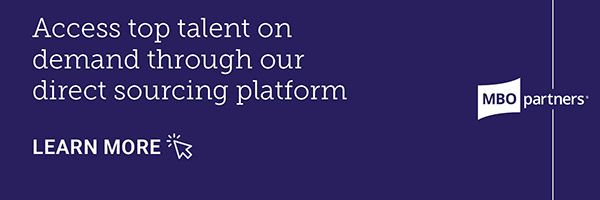How the Human Capital Market is Similar to the Financial Market

- To help describe the “human capital” market, a parallel can be drawn to financial markets and the basic elements of managing investments.
- While there are many dynamics and nuances with different marketplaces, three components that markets involving investment have in common are acquisition, enablement, and management.
- HR professionals are likely quite familiar with the proliferation of technologies related to candidate relationship management, private talent networks, employer branding, and skills-based networks.
Understanding the dynamics of the marketplace is helpful for any business seeking to develop strategies to maximize the value of independent contractors. To help describe the “human capital” market, a parallel can be drawn to financial markets and the basic elements of managing investments.
Whether you’re building your personal portfolio or executing a strategic business plan, it is the role of management to deploy capital to achieve an effective return. Below, we take a deeper dive into this parallel, the processes involved, and how to efficiently and effectively execute a strong independent workforce engagement strategy.
The Investment Lifecycle of the Independent Workforce
While there are many dynamics and nuances with different marketplaces, three components that markets involving investment have in common are acquisition, enablement, and management. These components, or dimensions, can be thought of as an investment “Lifecycle”. This model helps to describe investing in financial products as well as investing in human capital.
Today’s global financial markets are incredibly complex and interrelated—there are many lenses that can be helpful in analyzing these markets. Independent workforce markets are also complex and navigating the network of technologies, solution models, and regulatory influences on this market can be a daunting task. For the purposes of this discussion, we’ll be looking at the simple model of the investment lifecycle mentioned above. Our first focus will be on acquisition.
Acquisition is the First Step in the Talent Engagement Lifecycle
Acquisition is the first step in the lifecycle and involves researching, selecting, and purchasing an investment—in other words, “find and buy”. In financial markets, this entails picking and purchasing (or shorting) stocks, bonds, funds, REITs, options, etc. In the human capital market, acquisition involves job posting, recruiting, networking, resume development, job applications, interviewing, etc.
One pattern to recognize is that there are marketing and sales activities taking place to influence purchase decisions in both financial and human capital markets. In financial markets, there is an overwhelming number of information sources and products to navigate in order to determine what to buy. Financial news outlets are constantly highlighting stocks, online brokers have extraordinarily powerful research tools, there is a variety of trade screening applications, and “Black Box” trading systems are marketed to consumers.
As in financial markets, sales and marketing activities are constantly at play as candidates, employers, buyers, and consultants market their capabilities and opportunities. Hiring organizations are employing strategies such as “Client of Choice”, employer branding, private talent networks, and engaging supply chain management programs such as MSPs, VMSs, and FMSs to attract skilled independent contractors to their companies. Likewise, individuals are building their marketability through skill development, successful delivery, references, certifications, online profiles, and many other techniques.
A second commonality is the clear emphasis, and related capital, on the development of products designed around the acquisition dimension of the investment market lifecycle. In financial markets, there are a number of ways this plays out, but one obvious example is the proliferation of funds (ETFs, mutual funds, hedge funds, structured notes, etc.). These products package and repackage financial assets and are rewarded by a variety of sales, transactions, and management fees. In all fairness, many of these products are great vehicles for investors to achieve their investment objectives, but it is a very crowded space. One interesting statistic is that there are more funds in the US than there are individual stocks.
Similarly, in Human Capital there is a proliferation of products designed around facilitating independent contractor acquisition. Over the past few years there have been a large number of FMS systems—in fact, several hundred at this point—introduced to the market to provide access to independent professionals and freelancers.
HR professionals are likely quite familiar with the proliferation of technologies related to candidate relationship management, private talent networks, employer branding, and skills-based networks. Similar to what we see in the financial markets, the products in the Human Capital space are very crowded, which can lead to challenges in navigating toward an effective engagement model to attract critical skilled workers to your organization.
This emphasis on the “purchase” event is understandable as there are motivational drivers involved with consumer behavior that are heavily influenced by cultural and psychological factors. The net result is that there is a significant amount of money directed at product development efforts related to solutions focused on transactions leading to a purchase event.
Important Nuances in Supply and Demand
One key difference between financial and human capital markets is the dynamic of supply and demand. In financial markets, buyers and sellers settle the question of value primarily based on price. For example, the market will for the most part incorporate all of the known information about a particular stock or commodity and determine a fair price for that asset. This is known as market efficiency and is a common tenet of global trading systems.
Supply and demand looks very different in the human capital market, which requires a more sophisticated model to complete a transaction. The independent contractor market is a “matching market,” which means that connecting supply and demand is not determined primarily by price and requires both parties to select each other. In this type of market, flexible decision models need to be used and adapted to specific scenarios. In this type of market, questions such as “is this person a fit,” “do I want to work in this environment,” “is this project interesting,” and “I know my friend Mr. Pink can help close a deal I’m working on; can I get him engaged to make that happen?” are more important than zeroing in on a price first. We’ll explore the concepts of matching markets further in future posts.
3 Key Takeaways
- It’s important to recognize that any independent contractor engagement strategy is your investment in the success of your company and the engagement of independent workers is a critical component of that strategy, particularly with the dynamics of today’s market
- There is an overwhelming number of technology solutions in the consultant market today, some of which can provide strategic value, but most of which are probably a distraction—find a trusted advisor to help with navigating this space
- In evaluating engagement models for independent professionals, it’s important to consider the needs of the independent, which includes recognition of unique value, flexibility, and support of an independent’s relationship network
In the next post of this series, we’ll explore similar parallels with the enablement and management dimensions of the lifecycle.
In conclusion, a manager should look at their engagement of independent contractors as an investment. They must engage resources that are going to help their company achieve an effective return and achieve peak performance.
Ready to make the investment? Contact us today—we’d be glad to discuss the right methods and approach to help your enterprise acquire skilled independent contractors.
John Dahlberg, VP Solutions Design, leads the Solutions Design and Delivery Team in its integration and delivery of MBO’s comprehensive suite of independent workforce engagement solutions to enterprise clients and strategic partners.
Categories
Subscribe to the Insights blog to get weekly insights on the next way of working
Source, engage, and manage top talent talent through MBO's direct sourcing platform
Learn more about MBO
Learn how to start, run and grow your business with expert insights from MBO Partners
Learn how to find, manage and retain top-tier independent talent for your independent workforce.
MBO Partners publishes influential reports, cited by government and other major media outlets.
Research and tools designed to uncover insights and develop groundbreaking solutions.



